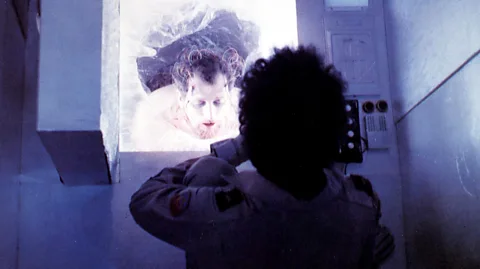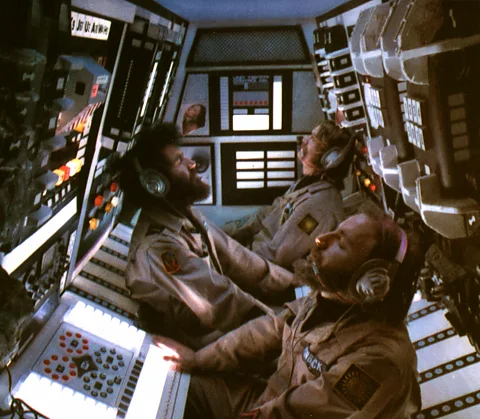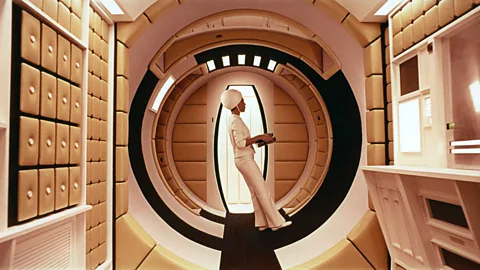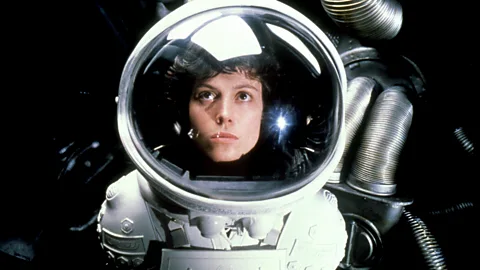Dark Star at 50: How a micro-budget student film changed sci-fi forever
 Getty Images
Getty ImagesIn the early 70s, young filmmakers John Carpenter and Dan O'Bannon created a spaceship tale for a graduation project – little knowing it would influence Alien and many other works.
Made for $60,000 (£47,581) by film school students, horror maestro John Carpenter's directorial debut Dark Star is now regarded as a sci-fi cult classic. Having just turned 50 years old, it's a world away from much of the sci-fi that came before it and would come after, neither space odyssey nor space opera, rather a bleak, downbeat and often absurd portrait of a group of people cooped together in a malfunctioning interstellar tin can. Arguably its most famous scene consists of an existential debate between an astronaut and a sentient bomb.
Dark Star was a collaboration between Carpenter, who directed and scored the film, and Dan O'Bannon, who in addition to co-writing the script, acted as editor, production designer, and visual effects supervisor, as well as playing the volatile, paranoid Sergeant Pinback. They met as budding filmmakers at the University of Southern California. "While [Carpenter and O'Bannon] couldn't be more dissimilar in personality, they were both very energetic and focused," says Daniel Griffiths, director of Let There Be Light: The Odyssey of Dark Star (2010), the definitive documentary about the making of the film.
 Getty Images
Getty ImagesSet in the year 2250, the film charts the exploits of the titular space vessel as it meanders round the galaxy blowing up "unstable" planets. The hirsute five-man crew has been stuck on the ship for 20 years and are bored out of their minds and fed up with each other. They spend their days bickering and fixing the ship, which is constantly failing them in some way, including with the loss of the ship's supply of toilet roll. There's not much in the way of plot. The film has an almost defiantly anti-dramatic quality at times, with its focus on the dreariness of the long space voyage. "O'Bannon believed space travel would be a tedious experience, filled with seemingly endless days of maintenance and reflection," says Griffiths. Carpenter famously referred to it as "Waiting for Godot in space".
In addition to Pinback, the other crew members consist of a group of long-haired oddballs (their sojourn in deep space has no doubt contributed to their oddness). Lieutenant Doolittle, the ranking officer, is a former surfer; Sergeant Talby is a loner who likes to hang out in the observation dome at the top of the ship, while the crew is completed by Sergeant Boiler, who passes the time rapidly jabbing a knife blade between his fingers, (much as the android Bishop would do in Aliens). The ship's unfortunate Commander Powell is kept in a state of suspended animation, frozen in a block of ice in the ship's hold.
A step into the absurd
The sci-fi films of this period tended to be bleak and dystopian, explains John Kenneth Muir, author of The Films of John Carpenter – films like Silent Running (1972), in which all plant life on Earth is extinct, or George Lucas's 1971 debut THX-1138, in which human emotion is suppressed. "Dark Star arrived in this world of dark, hopeless imaginings, but took the darkness one step further into absurd nihilism."
Carpenter and O'Bannon set out to make the "ultimate riff on Stanley Kubrick's 2001: A Space Odyssey," says Griffiths. While Kubrick's 1968 film, explains Muir, was one "in which viewers sought meaning in the stars about the nature of humanity, there is no meaning to life in Dark Star". Rather, says Muir, it parodies 2001 "with its own sense of man's irrelevance in the scheme of things". Where Kubrick scored his film with classical music, Dark Star opens with a country song, Benson, Arizona. (A road in the real-life Benson is named in honour of the film). The film was even released with the tagline "the spaced-out odyssey".
Dark Star captured the mood of the time in which it was made, says Muir, the atmosphere of Nixon's America. "The 1960s was all about utopian dreaming and bringing change to America in the counterculture. The 1970s represent what writer Johnny Byrne called 'The wake-up from the hippie dream', a reckoning with the fact that the more things change, the more they stay the same."
 Getty Images
Getty ImagesLet There Be Light charts Dark Star's journey from a graduation project to feature release. It shows the ingenuity of the creative team, constructing sets from ice cube trays and items scavenged from 99-cent stores. The limited budget forced them to be incredibly creative, using DIY methods to create the film's special effects, though some of these were more effective than others. They neglected to consider how the actors were supposed to breathe in the space suits, which made Brian Narelle's space-walk scenes as Doolittle all the harder to film as he could only deliver one line at a time before running low on air. For the cryogenic refrigeration unit scene, in which Doolittle visits the on-ice Powell, they misted the air with kerosene to make it look colder.
The production process took place between 1970-2, with long gaps between filming while they cobbled together money for more film. As Let There Be Light shows, it was quite a fraught process but they were determined to see it through. Because the film was made using USC equipment, the university had a claim over the resulting film's intellectual property, and so Carpenter and O'Bannon were concerned that that USC might sue them for trying to release it, though thankfully it never came to that. They found a distributor for it in Jack Harris, the producer best known at the time for The Blob (1958). He saw potential in the film, but, says Griffiths, "O'Bannon did not get along with Harris at all and Carpenter was often in the middle of it".
More like this:
At just an hour long it was too short for a cinematic release. Scenes had to be added to pad out the runtime to the requisite length. These additional scenes include a lengthy sequence in which Pinback does battle with an alien in the form of a beach ball with clawed feet. "Given their powerful personalities, [Carpenter and O'Bannon] collaborated very well during the production," says Griffiths. "But they often disagreed with the direction of the 'added on' material." The two men would not collaborate again after Dark Star.
Its rise to cult success
When Dark Star premiered at the FILMEX expo in 1974, the audience response was largely positive. "They recognised the film's absurdist humour and celebrated its student film roots," says Griffiths.
It had a limited theatrical release in 1975, but it was not a commercial success. "The film met with negative reviews from critics, and general disinterest from audiences," says Muir. "Both Carpenter and O'Bannon realised that all the struggles they endured to make the film did not matter to audiences, they only cared about the finished product. I think they were discouraged," says Griffiths.
The growth of the VHS market, however, helped it find its audience and propelled it towards cult status. Its influence can still be felt, perhaps most directly in Ridley Scott's Alien, for which O'Bannon, who died in 2009, wrote the screenplay. The two films share DNA. Alien is also set on a grotty working vessel with a bickering crew, only this time the alien wasn't played for laughs.
 Alamy
AlamyYou can see the influence of Dark Star in Carpenter's subsequent filmography too. "There is a deep streak of anti-authoritarianism in much of Carpenter's film canon, as there is in Dark Star," says Muir, who points out you can see the same qualities in a lot of the protagonists of his later films, in Escape from New York's Snake Plissken and MacReady in The Thing, another film about men stuck together, growing increasingly paranoid and distrustful of one another.
Writer Doug Naylor, the co-creator of BBC space sitcom Red Dwarf, remembers watching Dark Star on video with his writing partner Rob Grant. "It was grungy. A different kind of sci-fi than we'd been used to seeing." They both agreed the scenario would make a great basis for a sitcom, he says, "then we did nothing about it for several years".
Eventually they did return to the idea. He and Grant first explored this thematic ground in their radio sketch Dave Hollins: Space Cadet, "about the lone survivor of a space accident going slowly crazy," before writing Red Dwarf, in which vending machine repair man Dave Lister finds himself the last human left alive, stranded on a mining vessel three million years in the future with a hologram of a man he despised and a creature that evolved from his pet cat. You can see elements of Dark Star in the passive aggression bickering that characterised its early series, with their balsa wood sets, the humour undercut with a bleak, existential streak – but also in the sense of ordinariness that permeated the show, despite the fact it was set in space.
"It was about ordinary guys getting on each other's nerves and that's what we thought was so hilarious," says Naylor. The show might have been set three million years in the future, but fundamentally it was about dead-end jobs, "and Rob and I had both had dead-end jobs, so we could write that". Red Dwarf is still running over 30 years on, a contender for one of the longest running shows to still feature the same cast. "The seed of that was Dark Star," says Naylor.
You can still also nods to Dark Star in 21st Century films like Alex Garland and Danny Boyle's 2007 sci-fi Sunshine and, arguably, Marvel's Guardians of the Galaxy series. Despite its micro-budget beginning and props made from old vacuum cleaner parts, Dark Star has endured.
--
If you liked this story, sign up for The Essential List newsletter – a handpicked selection of features, videos and can't-miss news delivered to your inbox every Friday.
